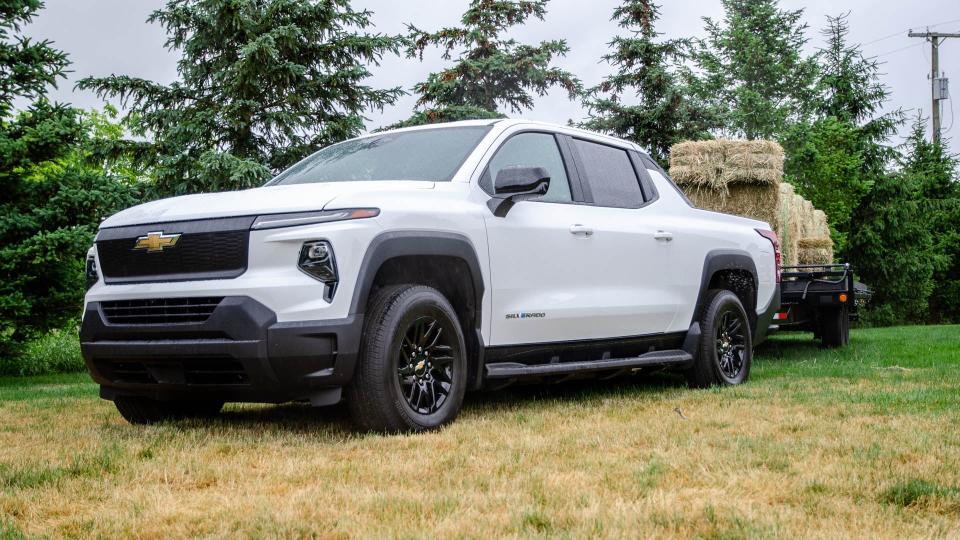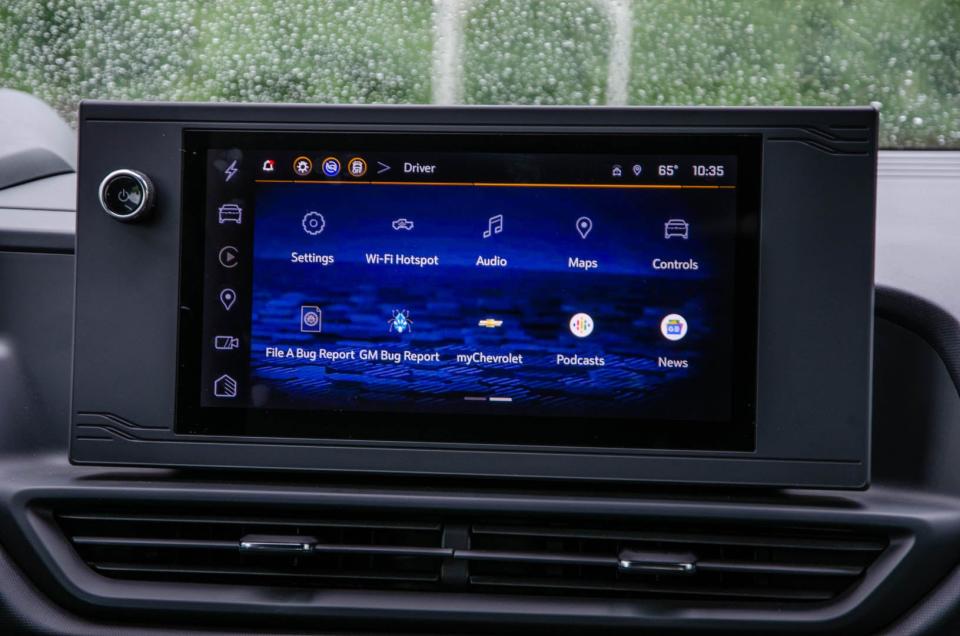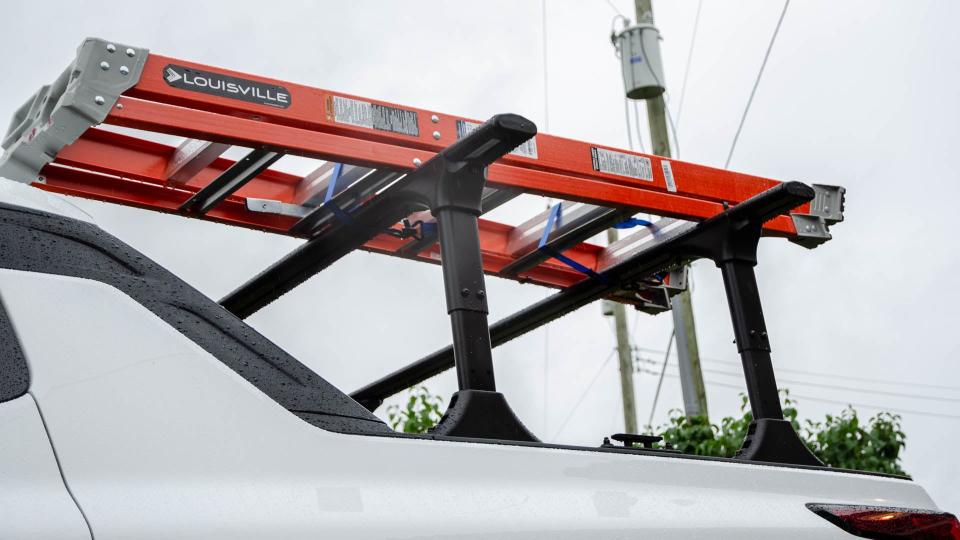2024 Chevy Silverado EV WT First Drive Review: Good Work Doesn't Come Cheap

The 2024 Chevy Silverado EV is the first mass-market counterpunch to the Ford F-150 Lightning. Rivian already sells the adventure-ready R1T, though the battery-powered Bowtie has a totally different everyday ethos. Then there's Ram, which is working on the 1500 REV, but that won't come out until late next year. As such, there's a ton (or several) riding on the Silverado EV to be a big hit for General Motors.
The first model to launch will be the utilitarian WT trim aimed at fleet services, contractors, and small businesses; it'll be available to the general public a little while later. As such, that’s the truck I had the chance to test in Michigan last week. I'll come straight out and say that the future of electric pickups is seriously bright—and also seriously expensive, but you probably knew that already.
You can't deny that the Silverado EV WT is impressive. Unless you have some unwavering brand allegiance to the Blue Oval, there's no reason to. Still, the modestly optioned 4WT models I tried cost $79,800, and not every handyman can afford to drive one while still making money. That doesn't undercut its capability, but it undoubtedly makes it a tougher sell for its commercial audience.

2024 Chevy Silverado EV WT Specs
Base price WT (4WT as tested): $TBA ($79,800)
Powertrain: dual-motor | 1-speed automatic | all-wheel drive
Horsepower: 510
Torque: 615 lb-ft
Seating capacity: 5
Curb weight: N/A
Max towing capacity: 10,000 pounds
Max payload capacity: 1,440 pounds
Front trunk cargo volume: 10.7 cubic feet
Range: 450 miles
Quick take: A deeply impressive, well-rounded work truck that’s far more capable and comfortable than it needs to be. But about that cost...
Score: 8/10
The Basics
Whereas Ford expedited its electric pickup by stuffing batteries into the F-150’s ladder frame, GM has taken a slower, more thorough approach. The result is a Silverado EV that isn’t related in any fundamental way to the gas-powered truck. It's built on GM’s dedicated Ultium platform, similar to the GMC Hummer EV, just with a bigger focus on work than Crab Walking its way through off-road trails.
It’s immediately evident that the Silverado EV isn’t your average Chevy pickup, mostly because it looks completely different from its fossil-fueled sibling. It’s smoother, sleeker, and sportier. Those C-pillar bed sails give it a futuristic Chevy Avalanche look, and they’re also functional. According to the automaker, they clean up the turbulent air behind the cab, helping to improve its aero. In fact, with a drag coefficient of .331, the Silverado EV is the slipperiest pickup you can buy. The result of that, and a whopping battery pack, is an astounding 450 miles of EPA-estimated range.







Being a work truck, the Silverado EV WT’s interior is pretty plain. There’s a ton of hard-touch plastics and a one-note color scheme. That's OK because the WT’s interior is meant to take a daily beating from boots, tools, and filthy workers. Chevy wanted it to be easy to wash down with a hose and blow out with a leaf blower, so don’t get the WT for its creature comforts unless you're coming from a Squarebody or something. That said, it feels well-built, its touchscreen infotainment system is clear and works well, the seats are comfy, and it was even surprisingly quiet on the road, given that there’s barely any sound insulation in the cab. It’s easily the most comfortable work truck I’ve been in and, while riding as a passenger, I actually forgot it was a work truck for a bit.
Powering the WT is a dual-motor setup giving it all-wheel drive, 510 hp, and 615 lb-ft of torque. That level of power may not snap your neck like the upcoming Silverado EV RST’s 754 hp and 785 lb-ft, but it’s way more than enough for a rig that's meant for towing and hauling.
Driving the Chevy Silverado EV WT
Since the Silverado EVs we drove were genuine workhorses, work is what we made them do. The test took place on a mix of pavement and dirt roads with a designated tow loop to see how they’d handle all the scenarios you’d use a traditional gas truck in. Chevy also showed off what the Silverado EV can do better than an internal-combustion pickup, like its ability to double as a mobile generator with up to 10 outlets and 10.2 kilowatts of power.

I had the chance to drive through highway traffic and on some twisty roads without a trailer. I can confidently say that there’s a lot to like as the ride is solid and comfortable, with only a bit of choppiness over the rough Michigan pavement. Like other electric trucks on sale today, the Silverado EV rides on four-wheel independent suspension, which definitely helps the ride. Its steering is also nicely weighted with a heft that reminds you of what you’re driving, and the front end is accurate. It feels more like driving a sporty SUV than it does a pickup.
Visibility is surprisingly good for a pickup this size, especially forward where the Silverado EV’s low cowl provides an expansive view over the hood. Without an engine in the way, Chevy was able to lower the cowl and even push it forward for more cabin space. Ergonomically, it’s quite good, too, with no major complaints. Having the left stalk control turn signals, lights, and wipers is a bit confusing at first but it’s easy to get used to. Aside from that, it's a well-laid-out truck inside and the 4WT lacked the typical button blanks you find on less optioned models.



While the on-road and dirt portions of the test were pretty straightforward, I was a little anxious about towing. I've only ever owned small sport sedans, and while I'm comfortable on a race track or some twisting backroads, towing a 9,000-pound setup with a John Deere tractor was a mostly new experience. My nerves may have been misguided, though, as the Silverado EV WT worked like a charm. With the trailer brake adjusted and the truck in its tow/haul mode, the dual-motor setup made easy work of pulling the tractor around. As you'd expect from a rig with this much juice, it never once struggled to keep up with traffic or pull a hill.
Even more impressive was its regenerative braking, which has huge potential in work applications. Think of it as a strong exhaust brake that just so happens to feed power back into your battery. There are three regen options—Off, On, and High—and I kept it in the middle setting. It was able to slow the loaded Silverado EV to a stop without me ever hitting the brake pedal. More than that, it didn't feel any different than it did without the trailer. So not only is its regen braking strong, Chevy's calibration is immensely impressive.
Chevy claims the Silverado EV WT can tow up to 10,000 pounds—up from the original 8,000-pound claim—and an eventual max tow package will supposedly bump that up to 20,000 pounds. Unfortunately, Chevy wouldn't say what sort of changes it'll make to achieve that figure. The truck already has eight-lug hubs like a heavy-duty pickup, but you have to remember that it's significantly heftier than a half-ton with a V8.
The Highs and Lows
There's a lot to like about the Silverado EV WT. It looks good (I've decided), its interior is spacious and comfortable, and it delivers sports car acceleration with the ability to achieve 450 miles of range if you keep your foot out of it. It handles well, there's excellent visibility, and it can be used to charge tools, equipment, and even other EVs. Heck, it can even power your home.







It isn't all positive, though. Fully spec'd, the Silverado EV WT costs more than a gas High Country model, which is the truck's top trim with a way better interior. For that, the WT version still lacks the highly hyped midgate and four-wheel steering that other Silverado EVs get. There are going to be cheaper versions but they're going to drop power and range. Chevy plans a 3WT version to launch next, and it has the same powertrain with a smaller density battery pack that drops its max range to 350 miles. That will still cost $74,800.
Chevy Silverado EV WT Features, Options, and Competition
Since we haven't seen the true base WT yet, it's tough to say which features you'll get across the board. The 4WT comes with just about everything you can get without stepping up to the Trail Boss trim, which is next in line below the Silverado EV RST. There's the sizeable touchscreen infotainment screen, a digital gauge cluster, keyless entry, a lockable tailgate, a waterproof front trunk (which has a soft-close latch), and yeah, even a power-adjustable steering column.








As far as competition goes, the Chevy Silverado EV WT is in a class of two. Its lone rival at the moment is the F-150 Lightning Pro, which is only available to non-fleet customers with the standard range battery. The Silverado EV 4WT naturally beats it in most measurable performance metrics with 510 hp compared to the Ford's 462, a 450-mile range versus the Lightning's 240, and 10,000 pounds of towing rather than 5,000 for the base electric F-150. Again, none of this is surprising considering the F-150 Lightning Pro starts at a little more than $60,000, and the real comparison will come when a more basic version of the Silverado EV drops.
Range, Charging, and Efficiency
The top-spec, biggest battery Silverado EV WT is estimated by the EPA to net 450 miles of range. I didn't drive the truck even close to enough during my test to get a good grasp of its range in the real world. Additionally, the digital gauges didn't explicitly show miles per kilowatt-hour, so I couldn't tell how efficient it was during my drive. Chevy was also coy on battery capacity, efficiency, and total charging speed details.
However, the electric Chevy is capable of 350-kilowatt charging and can regain around 100 miles every 10 minutes at that power level. Try as I did to learn more about the charge curve, Chevy's engineers wouldn't budge, so it's unclear how long it can charge at that speed.
Value and Verdict
Without question, the Chevy Silverado EV WT is one of the most impressive pickups I've ever driven. When a relatively basic work truck version is this comfortable and capable, it sticks with you. It's quick, surprisingly fun to drive, comfortable, spacious, quiet at speed, practical, packed with useful features, good-looking, and has a massive range. Of course, all of that comes at a cost. It's up to you to decide if it's worth it for your purposes.

Regardless of which trim you choose, you aren't getting into a Silverado EV for cheap anytime soon. That said, the range figure alone gives a lot of hope to those considering an electric work truck. There isn't much that an internal combustion Silverado can do better than the EV aside from refueling quicker, and if you're looking to future-proof your fleet, this feels like the best option. The jury is still out on serviceability—we know it'll be more difficult with EVs—but the reality is that the days are numbered for internal combustion trucks. When the price eventually levels out, it'll be a lot easier to justify one of these, especially considering how much you can do with them.
Got tips? Send 'em to tips@thedrive.com

 Yahoo Autos
Yahoo Autos 